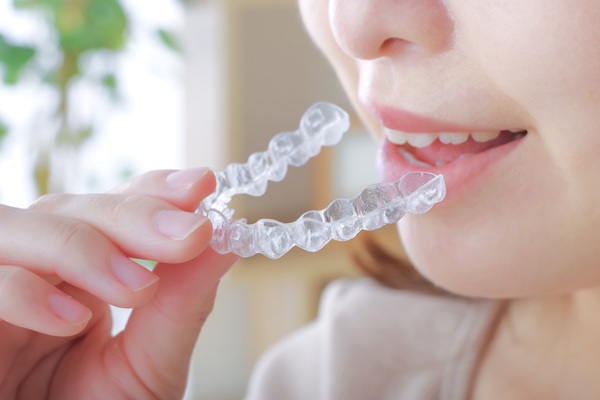Orthodontic Issues Invisalign Can Treat

If a patient suffers from misaligned teeth or a misaligned bite, Invisalign® clear aligners might be the solution they need to ensure their smiles stay bright – and straight! As one of the most trusted clear aligner systems will help straighten teeth and correct the bite without wires and brackets, meaning that patients can smile confidently while the aligners do their work. This no-fuss solution is ideal for people who want a straight smile, but prefer for their tratement to be a little less obvious.
Patients will remove the trays for brushing, flossing, eating, and special occasions as needed. Those who opt for traditional metal braces often have issues with oral hygiene, which can lead to straight but unhealthy smiles. They typically tend to be painful and can cause embarrassing smiles. When using clear aligners, patients bypass these issues and can feel confident throughout the straightening process. However, it is important that patients understand that they must consistently wear the trays even though they are removable.
This aligner can be used by adults and teenagers as a solution for first-time straightening but can also be used to realign teeth that have shifted after braces have been removed, primarily in adults who had braces in their youth. A dentist can evaluate each patient's smile and history to determine if they are a good candidate for this type of treatment.
How does Invisalign work?
Of course, patients are curious about how this process works and what they should expect from start to finish. Like other clear aligners, Invisalign are removable, plastic-tray straighteners custom-made for existing teeth and bite to help adjust them to the desired placement and bite. Aligners are made to be replaced every 2-3 weeks based on the assigned treatment plan, and each tray works to move the teeth to the predetermined alignment slightly. A dentist will help determine the patient's treatment plan and guide the process of when to replace the aligners.
Depending on the amount of movement required, treatment can take as little as six months, and most see results within a few weeks. On average, treatment takes 12-18 months but can vary greatly. Patients will want to wear your aligners for 20-22 hours per day to ensure that they see the results they desire.
One of the biggest draws of this aligner is the almost invisible appearance that separates it from traditional braces that are visible. In addition to the invisible appearance, aligners can be removed to ensure proper brushing and flossing, which is an extreme improvement over metal braces, often leading to poor oral hygiene. They are also an extremely comfortable way to experience the benefits of straightened teeth without the pain or inconvenience of traditional metal brackets. Patients are also able to remove them for special occasions without effort or interference in their treatment process.
Of course, to ensure that the treatment goes smoothly, patients should follow the guidance of their dentist. Proper cleaning, storage, and use is necessary to achieve the desired results.
What happens when treatment is complete?
Following treatment, there are some key considerations that patients much keep in mind. When patients have completed their straightening treatment, the dentist will provide them with a retainer which is key to maintaining their newly straightened smile and bite. They will wear their retainer regularly; then, as prescribed by the dentist, the patient will be able to cut back on the time they need to wear them, often wearing them only at night. It's important to keep the retainer stored properly and out of the reach of small children and pets who may lose or damage the retainer.
It is likely that the dentist will request mutliple follow-up visits to ensure that the patient's teeth still look straight and that there is no unwanted shifting. If shifting occurs, the dentist may require that you wear a retainer for longer throughout the day or opt for a permanent retainer that is installed behind the teeth.
Talk with a dentist about straightening options
A crooked simle can certainly have impacts on a self esteem and the overall function of the mouth. There are many solutions for this issue that a dentist can discuss with each patient. If a patient is looking for a non-intrusive method to straighten their teeth and bite, Invisalign is a great option that allows them to stay confident while achieving the straight smile they have dreamed of.
Request an appointment here: https://professionaldentalcare.net or call Professional Dental Care at (559) 554-3201 for an appointment in our Fresno office.
Check out what others are saying about our dental services on Yelp: Invisalign in Fresno, CA.
Related Posts
Advancements in orthodontics make it possible to achieve a straighter smile without the noticeable appearance of traditional metal braces. Clear braces provide an option that blends in with natural teeth, offering a more subtle approach to orthodontic treatment. Their translucent or tooth-colored materials allow individuals to correct alignment issues while maintaining a simple aesthetic.Clear braces…
Getting a smile makeover means getting at least one type of cosmetic dental treatment. You may want to improve your smile, but along with these treatments is the benefit of better oral health. Finding out more about this makeover can help you make informed decisions. Here are the details to consider about a smile makeover.The…
A smile makeover involves a treatment plan that improves a smile's appearance. It can involve a wide range of procedures, from dental and gum procedures to teeth straightening treatments. If you are considering this process to enhance your smile, here are some key things to know that will help you set yourself up for a…
Have you been feeling self-conscious about the appearance of your smile? A smile makeover may be what you need to transform your teeth and boost your confidence. From deeply stained teeth to malocclusions, a smile makeover can improve the appearance of your smile and overall well-being.A smile makeover is a comprehensive treatment method that utilizes…
